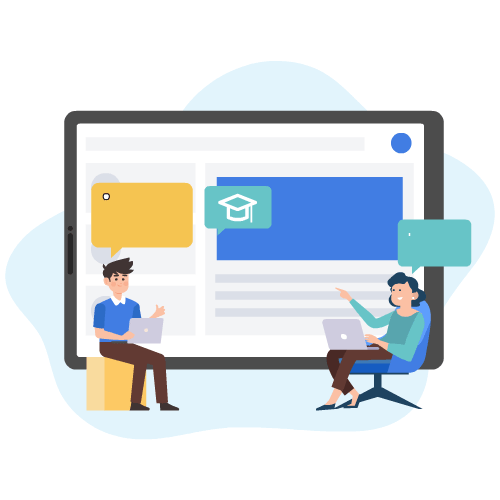Effective eLearning is no longer just about delivering information—it’s about creating meaningful, impactful experiences that drive engagement, retention, and growth. For organizations in education, healthcare, and beyond, the ability to offer personalized, accessible, and interactive learning solutions has become a critical success factor. As we approach 2025, the focus has shifted to designing learning systems that seamlessly integrate into workflows, empower users with real-world applications, and support continuous professional development.
Below are the top 10 trends shaping how companies and institutions can create, enhance, and automate their eLearning programs to stay ahead in an increasingly competitive landscape.
In times of change, learners inherit the earth, while the learned find themselves beautifully equipped to deal with a world that no longer exists.
Eric Hoffer, American Philosopher
Personalized Paths Designed by Experts
Imagine stepping into a classroom where everything—from the pace to the topics—is adjusted to fit your learning style and career aspirations. That’s what personalized learning paths bring to the table. These aren’t generic modules strung together. They’re curated journeys, shaped by expert insights, designed to close skill gaps and meet individual goals.
For example, an employee pursuing a leadership role in healthcare might follow a tailored program that combines communication strategies, data-driven decision-making, and emotional intelligence—all presented in a sequence that feels intuitive, not overwhelming. This isn’t just efficient; it’s empowering. Learners feel a sense of ownership, knowing the content was built with them in mind.
Augmented and Virtual Reality (AR/VR)
Picture a nurse training for emergency situations who can “step into” a virtual trauma unit or an engineer practicing complex machinery repairs in a simulated environment. AR and VR are making this possible. By overlaying information in the real world or immersing learners in entirely virtual ones, this technology brings education to life.
Instead of reading about a process or watching a video, learners interact with their environment. Mistakes become learning moments without real-world consequences, and theoretical concepts become tangible. As AR and VR become more accessible, they’re no longer a luxury—they’re a necessity for industries where experiential learning is critical.
Seamless Integration into Work Tools
What if learning didn’t require opening a new tab or signing into a separate platform? What if it was already where you are—within your everyday work tools? That’s the promise of eLearning integration into platforms like Slack, Microsoft Teams, and CRMs.
For example, a sales rep navigating their day might receive an automatic prompt in their CRM with a short refresher on handling customer objections, delivered right when they need it most. This “learning in the flow of work” approach eliminates friction. Training is no longer a break from work—it’s woven into it, making continuous learning feel effortless.

Gamification and Social Learning
People love to compete, collaborate, and achieve goals—it’s part of our nature. Gamification taps into this by introducing points, badges, leaderboards, and rewards to keep learners engaged. But this isn’t just about adding bells and whistles. When combined with social learning, where peers can collaborate, discuss, and share insights, it creates a rich, interactive learning environment.
Imagine a global marketing team where employees from different regions take part in a knowledge-sharing challenge, earning points for creative campaign ideas. The result? More interaction, higher retention, and stronger team dynamics—all while mastering the content.
Real-Time Compliance Training
Industries like finance, healthcare, and law live by one rule: stay compliant or risk severe penalties. But compliance training doesn’t have to be tedious. eLearning platforms are now delivering real-time, updated modules that respond to regulatory changes as they happen.
Picture a financial analyst receiving a concise, interactive update the moment a new policy is introduced. Instead of poring through a lengthy PDF, they engage with a brief, interactive course tailored to highlight the most relevant information. This kind of training not only ensures compliance but also respects the learner’s time.

Enhanced Analytics for Outcomes
The days of guessing whether a training program is effective are over. Advanced learning analytics now provide a clear picture of how learners are progressing, which parts of the course they’re engaging with, and where they’re struggling. This data isn’t just numbers—it tells a story.
For example, if 80% of participants in a sales training module drop off during the negotiation exercise, it signals the need for a redesign. Organizations can adjust courses in real time, ensuring that learners aren’t just completing modules but mastering the material.
The Importance of Human-Created Content
In an era where automation is everywhere, there’s still something irreplaceable about content created by real experts. Human-crafted learning materials bring nuance, empathy, and relevance that templated content often lacks.
Take an instructional video on conflict resolution. A well-crafted example might use authentic scenarios that reflect cultural differences, showing learners not only what to say but how to say it. These kinds of human touches deepen the learning experience and make the content feel relatable and trustworthy.

Mentoring That Reaches Everyone
Mentorship has always been a cornerstone of professional growth, but it’s often limited to select individuals. eLearning platforms are changing this by offering scalable coaching and mentoring programs. Learners can connect with mentors virtually, participate in live feedback sessions, and receive personalized guidance.
A junior manager in a remote office, for instance, can now receive the same quality of mentorship as their counterpart at headquarters, ensuring no one is left behind. By democratizing access to expert advice, organizations foster growth at every level.
Internal Mobility and Skill Development
The future of work isn’t just about hiring—it’s about growing the talent you already have. eLearning programs focused on internal mobility empower employees to reskill and upskill, opening doors to new roles within the company.
For example, a customer support specialist might complete a program that transitions them into a data analyst role, benefiting both the employee and the organization. By investing in internal development, companies not only fill critical roles but also build loyalty and retain institutional knowledge.
Strategic Investment in eLearning
Forward-thinking organizations view eLearning as a strategic advantage, not just a training tool. This shift has led to increased investment in comprehensive digital learning solutions that align with long-term goals.
Consider a tech company launching a global expansion. By investing in multilingual training programs, they ensure that employees in different regions receive consistent, high-quality training. This strategic approach amplifies impact, driving growth and ensuring that learning supports the broader mission.

The Role of GoToElearning.com in Driving eLearning Transformation
Implementing these trends isn’t just about adopting new tools—it’s about rethinking how learning happens. That’s where GoToElearning.com, a division of California-based Mokhtar Group, excels. With decades of experience in custom eLearning solutions, GoToElearning.com helps organizations seamlessly integrate trends like personalized learning paths, gamification, and mentoring at scale.
From designing immersive AR/VR experiences to embedding training into everyday workflows, GoToElearning.com partners with clients to create innovative, impactful learning ecosystems. By staying ahead of the curve and prioritizing client needs, they ensure that organizations don’t just adopt trends—they lead the way in shaping the future of learning.
In 2025 and beyond, learning will continue to evolve. With the right strategies and partners, the possibilities for growth and transformation are limitless.





